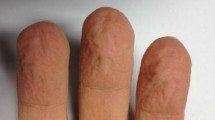Abstract
Finite element models of skin were developed to determine the effects of wetness, age, and wrinkles on mechanical strains and stresses in the stratum corneum (SC) as related to skin lesions. We modeled two geometries, young (0.12-mm-deep wrinkles) and aged (0.18-mm-deep wrinkles), and for each geometry, three loading conditions were applied (compression in a dry environment, compression and shear in dryness, and compression with shear in wetness). Effects of skin wrinkling were studied independently or while coupled with age-related mechanical property changes. For each simulation, we calculated the peak maximal shear strain and stress in the SC, peak shear stress on the skin surface, and volumetric exposure of the SC to potentially injurious shear stresses (<70 kPa). Compression and shear with wetness produced the highest skin surface loads. Volumetric exposure of aged skin to potentially injurious shear stresses was six times greater than in the young skin for these conditions. Deeper wrinkles caused elevated loads in the SC consistently for all outcome measures and independently of the age factor. Thinning and/or stiffening the SC increased both the surface and internal SC stresses. Our findings indicate that theoretically, wetness, skin aging, and/or skin wrinkling are all risk factors for skin lesions such as superficial pressure ulcers.





Similar content being viewed by others
References
Agam L, Gefen A (2007) Pressure ulcers and deep tissue injury: a bioengineering perspective. J Wound Care 16(8):336–342
Batisse D, Bazin R, Baldeweck T, Querleux B, Leveque JL (2002) Influence of age on the wrinkling capacities of skin. Skin Res Technol 8(3):148–154
Bots TC, Apotheker BF (2004) The prevention of heel pressure ulcers using a hydropolymer dressing in surgical patients. J Wound Care 13(9):375–378
Flynn C, McCormack BA (2008) Finite element modelling of forearm skin wrinkling. Skin Res Technol 14(3):261–269
Flynn C, McCormack BA (2009) Simulating the wrinkling and aging of skin with a multi-layer finite element model. J Biomech 43(3):442–448
Flynn C, McCormack BA (2009) A three-layer model of skin and its application in simulating wrinkling. Comput Methods Biomech Biomed Eng 12(2):125–134
Garcia AD, Thomas DR (2006) Assessment and management of chronic pressure ulcers in the elderly. Med Clin North Am 90(5):925–944
Gefen A (2007) Pressure-sensing devices for assessment of soft tissue loading under bony prominences: technological concepts and clinical utilization. Wounds 19:350–362
Gefen A (2007) Risk factors for a pressure-related deep tissue injury: a theoretical model. Med Biol Eng Comput 45(6):563–573
Gerhardt LC, Mattle N, Schrade GU, Spencer ND, Derler S (2008) Study of skin-fabric interactions of relevance to decubitus: friction and contact-pressure measurements. Skin Res Technol 14(1):77–88
Gerhardt LC, Strassle V, Lenz A, Spencer ND, Derler S (2008) Influence of epidermal hydration on the friction of human skin against textiles. J R Soc Interface 5(28):1317–1328
Ghadially R, Brown BE, Sequeira-Martin SM, Feingold KR, Elias PM (1995) The aged epidermal permeability barrier. Structural, functional, and lipid biochemical abnormalities in humans and a senescent murine model. J Clin Invest 95(5):2281–2290
Goldstein B, Sanders J (1998) Skin response to repetitive mechanical stress: a new experimental model in pig. Arch Phys Med Rehabil 79(3):265–272
Hendriks FM, Brokken D, Oomens CW, Bader DL, Baaijens FP (2006) The relative contributions of different skin layers to the mechanical behavior of human skin in vivo using suction experiments. Med Eng Phys 28(3):259–266
Li L, Mac-Mary S, Marsaut D, Sainthillier JM, Nouveau S, Gharbi T, de Lacharriere O, Humbert P (2006) Age-related changes in skin topography and microcirculation. Arch Dermatol Res 297(9):412–416
Lim D, Lin F, Hendrix RW, Moran B, Fasanati C, Makhsous M (2007) Evaluation of a new sitting concept designed for prevention of pressure ulcer on the buttock using finite element analysis. Med Biol Eng Comput 45(11):1079–1084
Linder-Ganz E, Gefen A (2009) Stress analyses coupled with damage laws to determine biomechanical risk factors for deep tissue injury during sitting. J Biomech Eng 131(1):011003
Magnenat-Thalmann N, Kalra P, Leveque JL, Bazin R, Batisse D, Querleux B (2002) A computational skin model: fold and wrinkle formation. IEEE Trans Inf Technol Biomed 6(4):317–323
Masaki F, Riko K, Seiji H, Shuhei Y, Aya Y (2007) Evaluation of pressure ulcers in 202 patients with cancer—do patients with cancer tend to develop pressure ulcers? Wounds 19(1):13–19
Nakagami G, Sanada H, Konya C, Kitagawa A, Tadaka E, Matsuyama Y (2007) Evaluation of a new pressure ulcer preventive dressing containing ceramide 2 with low frictional outer layer. J Adv Nurs 59(5):520–529
Nakagami G, Sanada H, Konya C, Kitagawa A, Tadaka E, Tabata K (2006) Comparison of two pressure ulcer preventive dressings for reducing shear force on the heel. J Wound Ostomy Continence Nurs 33(3):267–272
Ohura N, Ichioka S, Nakatsuka T, Shibata M (2005) Evaluating dressing materials for the prevention of shear force in the treatment of pressure ulcers. J Wound Care 14(9):401–404
Ohura T, Takahashi M, Ohura N (2008) Influence of external forces (pressure and shear force) on superficial layer and subcutis of porcine skin and effects of dressing materials: are dressing materials beneficial for reducing pressure and shear force in tissues? Wound Repair Regen 16(1):102–107
Reger SI, Ranganathan VK (2009) The importance of the microenvironment of support surfaces in the prevalence of pressure ulcers. In: Gefen A (ed) Bioengineering research of chronic wounds. Springer, Berlin, pp 85–100
Author information
Authors and Affiliations
Corresponding author
Rights and permissions
About this article
Cite this article
Sopher, R., Gefen, A. Effects of skin wrinkles, age and wetness on mechanical loads in the stratum corneum as related to skin lesions. Med Biol Eng Comput 49, 97–105 (2011). https://doi.org/10.1007/s11517-010-0673-3
Received:
Accepted:
Published:
Issue Date:
DOI: https://doi.org/10.1007/s11517-010-0673-3




